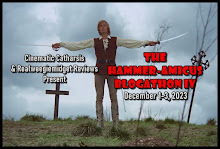In her hey day Julie Ege released two singles: Love/In One Of Your Weaker Moments (CBS 5431) – an interpretation of the John Lennon song – and, ahem, Touch Me/Stop It I Like It (Starbox SX 1158) in 1977. Producers had subsequently asked her to record an LP (that's a long playing record for all you teenies out there), but Ege refused as she never really considered herself to be a proper singer.
I am personally only familiar with In One Of Your Weaker Moments and, hmmm, what can I say about it without sounding too insulting?
OK! Remember William Shatner singing Lucy In the Sky With Diamonds? Well, Julie Ege’s track isn’t quite that bad… but only just.
She isn’t really singing this piece. She’s more talking through it while mainly being accompanied by a piano. You can get away with this style of song interpretation if you’re a guy and you’re name is Telly Savalas. For anyone else this is a cop out, especially when she does attempt a quasi-singing approach occasionally and consistently misses the right notes.
Based on that performance alone it is no surprise that she had to include a semi-nude picture of herself for her recording of John Lennon’s Love in order to instil some kind of interest in her single. Still, well worth checking out even just for curiosity’s sake. Graham Groom’s discussion group has an MP3 version of the song in their file section.
Ege also appeared as Columbia in the Norwegian language recording of The Rocky Horror Show. Originally recorded in Oslo on October 24 & 25, 1977, there have been several releases, both official and bootleg. The most recent release can be found on CD in 2002 by Universal Music AS (Catalog # 014728 2).
The Rocky Music site is well worth checking out as it has a lot of info on this particular recording. The entire CD is available as an MP3 download from Amazon. The site also has clips to listen to though Ege is not individually highlighted so appears to have possibly only contributed as part of the various artists involved in "Tiden blir skrudd" ("The Time Warp").
PLAGUE OF THE ZOMBIES (John Gilling, 1966)
-
A gang of ruffians and a rash of mysterious deaths frighten villagers into
a malignant malaise, fearing bubonic consequences and bombastic
recriminati...
1 year ago

































